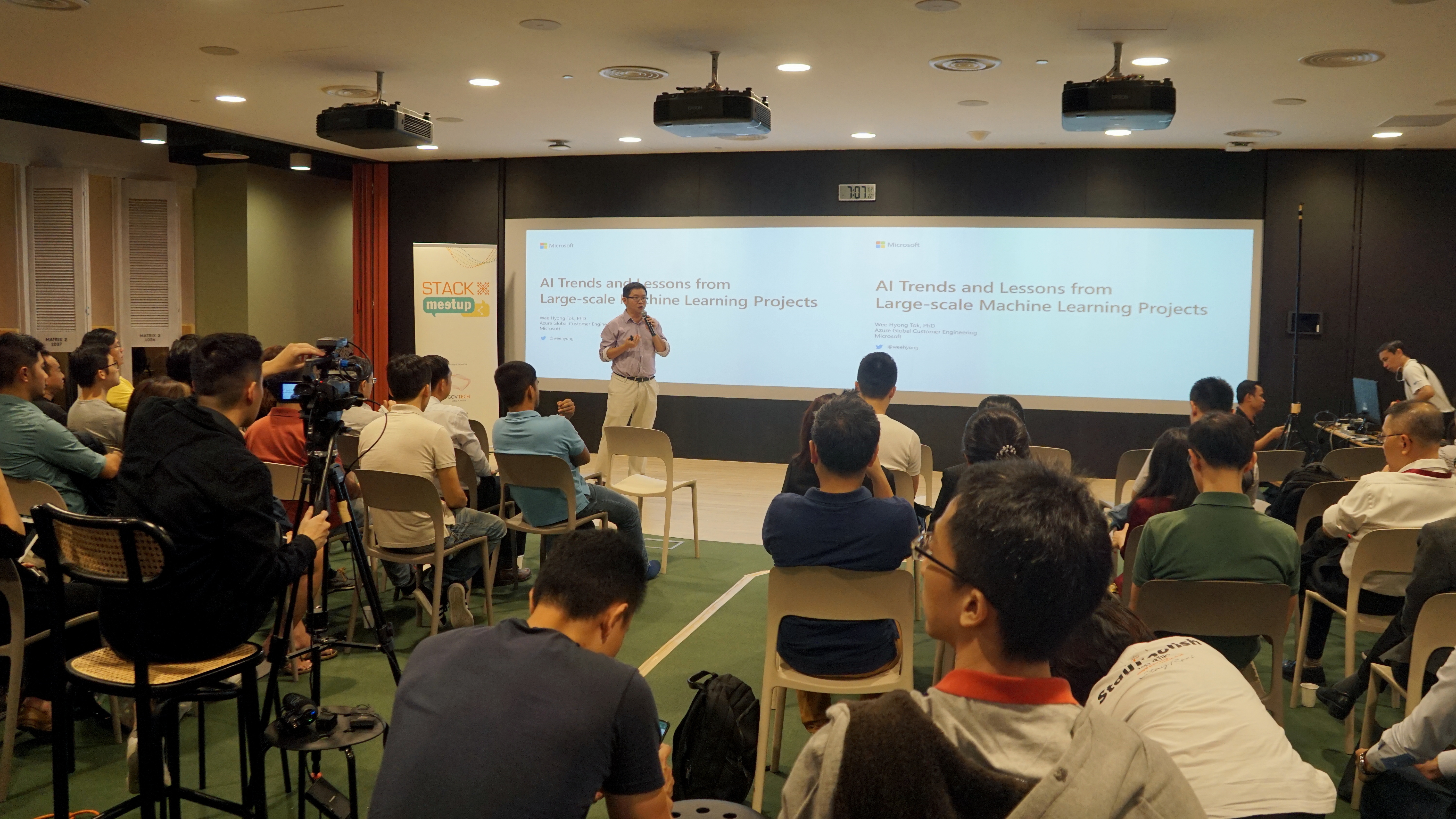Learning what machine learning can achieve

At the 4th GovTech STACK-X Meetup, two experts showcased some of the practical uses and latest advances in machine learning.
In simpler times, the word ‘training’ applied exclusively to living things—for instance, you could train a dog to perform a trick, or a person to excel at a sport. But nowadays, even machines can be trained to carry out specific tasks.
For something to be trainable, however, it must first be embedded with some form of capacity for learning, and this is indeed what computer scientists have enabled machines to do. This is the field of machine learning, an exciting and rapidly expanding frontier.
Giving audiences a flavour of the practical uses of machine learning were Dr Tok Wee Hyong, Principal Data Science Manager at Microsoft; and Mr Chong Jia Yi, distinguished engineer at the Government Technology Agency of Singapore (GovTech). They were speaking at the 4th GovTech STACK-X Meetup, a regular series of talks to engage the tech community.

Counting on AI
“Today, developments in machine learning and artificial intelligence (AI) are happening at an accelerated pace, but what is really important is that these are not just innovations in academia. A lot of the advancements are immediately applicable to real-world problems,” said Dr Tok.
For example, Project Natick at Microsoft seeks to deeply understand the challenges of deploying subsea datacenters worldwide; it is the world’s first deployed underwater datacenter and it was designed with an emphasis on sustainability. Together with the Project Natick team, Dr Tok and his team of data scientists used deep learning based object detection techniques to automate the monitoring and counting of marine lifeforms, and deeply understanding the impact of deploying subsea datacenters.
Dr Tok’s team also look at how they can solve some of the world’s toughest challenges, as part of the AI for Earth program. For example, the team worked on training segmentation models to perform land cover mapping for the whole of the United States.
Today, a large segment of the world’s population lacks access to trained radiologists, even when imaging equipment is readily available. His team investigated various approaches on using deep learning for predicting the diseases from chest x-ray images, and provide additional inputs to radiologists, and help them make better decisions. To aid interpretability of the results, his team used Class Activation Maps (CAM) to understand and explain the prediction results from the deep learning models,
Painting a graphic picture
Speaking of complex problems, creating lifelike simulations of objects and living things, such as those portrayed in video games or animated movies, used to be a manual and painstaking process. Now, with the help of machine learning, animators can achieve their vision of realistic digital characters with less hassle.
Mr Chong, distinguished engineer at GovTech, knows very well the potential of machine learning in graphics. Having worked with Pixar for close to ten years prior to joining GovTech, he was responsible for developing physics simulation and animation tools used in popular films such as WALL-E, Brave, Toy Story 3 and Up.

“For instance, I worked on a skin simulation for digital characters which was used on all the animals of the movie Brave,” he said, adding that mimicking how the skin slides across the body during movement is actually a pretty complicated problem to solve mathematically.
He stated that in recent years, Machine Learning, in particular in the field of Deep Learning, has enabled the generation of smooth dynamic motion via trained Neural Networks. Essentially, we are now able to train machines to figure out the algorithms/methods to animate or simulate dynamic characters. Deep Learning methods for computer graphics and animation allows the automatic generation of complex motion like fluids, skin/flesh/muscle and character run cycles. This is now an additional tool visual effects, animation studios and game companies use to improve the overall expressiveness of their characters.
But the holy grail of machine learning for graphics, according to Mr Chong, is “2D RGB to 3D human pose estimation”. Basically, this means taking a two-dimensional image (or video) of a person, then being able to correctly identify and assign the positions of the torso and limbs as if they were in three-dimensional space. Existing machine learning algorithms still have difficulty performing this task in a robust manner, but Mr Chong thinks that whoever can solve this problem well “will change the face of the motion capture industry as we know it.”
Clearly, the potential of machine learning is still largely untapped. Novel and useful applications of the technology are still waiting to emerge, limited only by our imagination.
https://www.tech.gov.sg/media/technews/learning-what-machine-learning-can-achieve
